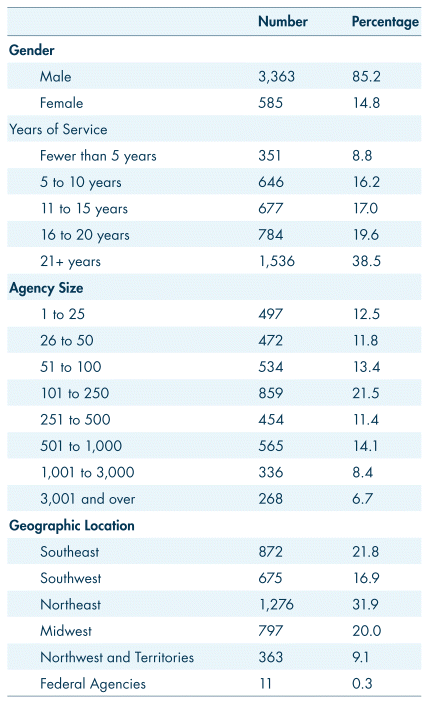
Jacqueline M. Drew*, Sherri Martin†
ABSTRACT
The current research provides a national snapshot of availability, access, and perceived effectiveness of wellness services and help-seeking stigma. This study is based on a sample of 3,994 police officers across the United States. The current study found a substantial percentage of officers are accessing wellness services, whether agency-provided, external, or a combination of both. Among officers who were most in need of wellness services, those experiencing some level of psychological distress, over 90% accessed at least one agency-provided or external service. Employee assistance program (EAP) services, formal and informal debriefings with managers and colleagues, chaplaincy services, and peer support were identified as some of the most common types of wellness programs provided by agencies and were also among the most effective wellness services as identified by officers who had accessed them. However, the research did highlight the need to consider gender, years of service, and agency size to provide a more nuanced view of psychological distress, support, and help-seeking stigma. Stigma associated with help-seeking remains a concern that must be addressed in police populations.
Key Words: Police, psychological distress, wellness services, help-seeking, stigma
In recent years, significant focus has been placed on developing and providing wellness services for first responders. As numbers of U.S. law enforcement officers who died by suicide surpassed those killed in the line of duty (Ruderman Family Foundation, 2018), law enforcement advocates and leaders sounded the alarm for examining and addressing this issue. This has been coupled with readily acknowledged high prevalence rates of depression, anxiety, and post-traumatic stress disorder within police populations (Carleton et al., 2020; Regehr et al., 2019). Underpinned by the Law Enforcement and Mental Health and Wellness Act (2017), police agencies and advocacy organizations across the United States are gaining increased funding and assembling wellness programs, offering an array of services aimed at increasing officer well-being and preventing law enforcement suicides.
With increasing resources and funding expended on service development, it is imperative to ensure that services are available to all of the law enforcement community, that they are being utilized, and that they are effective. Stigma around mental health concerns remains a significant barrier to help-seeking, reducing the likelihood that police will access support services (Drew & Martin, 2021). A review of the literature found that as many as one-third of all first responders experience mental health stigma (Haugen et al., 2017; Wheeler et al., 2021). Despite the apparent increased availability of wellness services, law enforcement populations still experience higher rates of mental health concerns than the general population (Carleton et al., 2020). As such, availability, access, and perceived effectiveness of wellness services and help-seeking stigma are the focus of the current study.
As noted, police organizations now increasingly offer an array of professional clinical and non-professional informal peer-based resources to their employees. Historically, the service offered most widely by law enforcement agencies has been employee assistance programs (EAPs). Despite broad access to EAPs, and the potential benefits EAPs present, they are generally underutilized. Asen and Colon (1995) found that within a New Jersey police department, 70.2% of officers were aware of the EAP program, but only 22% of those surveyed used EAP to assist with their mental health. Similarly, in a nationwide survey of law enforcement officers conducted by the National Fraternal Order of Police (2018), nearly 80% of respondents reported being aware of EAP services available to them, but barely 20% had accessed the service (Fraternal Order of Police (FOP), n.d.). Carleton et al. (2019) reported that most of the public safety personnel in their large Canadian sample (74%, n = 2,975) would first seek care from their spouse. This perhaps suggests that informal mental health services may be perceived as more desirable than more formal, clinical services.
Much emphasis has been placed on peer support programs. Horan and colleagues (2021) concluded that peer support interventions are effective at increasing self-efficacy and intention to communicate with peers regarding mental health, directly assessing intent to harm self or others, and encouraging treatment-seeking in first responders. Mental health education is also provided through peer support models in the military and has shown to enhance engagement in mental health services among veterans (Weir et al., 2017). Jeannette and Scoboria (2008) found that first responders preferred to debrief with a peer following a critical incident, but that, as the incidents increased in severity, they preferred a more formal intervention with a professional.
While we have some insight into specific types of wellness programs that are being used by U.S. police agencies, research tends to focus on specific programs in isolation, such as EAPs or peer support programs. Research that identifies and quantifies the full range and scope of wellness services that are available to police across the United States remains understudied (Taylor et al., 2022). We need to understand what types of services are available, whether they are available to all police personnel, regardless of the size of agency, and importantly, what types of services police officers are most likely to access. The Bureau of Justice Assistance (2022) has recently highlighted the challenges faced by smaller agencies where there may be a lack of mental health service providers with which to even partner. By studying the range of wellness services available across the United States, this study can provide valuable information as to the perceived comparative effectiveness of services through the lens of those officers who have used such services.
Barriers to help-seeking among law enforcement have been identified in the literature. Newell et al. (2022) identified three main barriers to help-seeking among police staff: stigma, worries about confidentiality, and occupation-specific experience with people in the community who present with mental distress. Corrigan (2004) identified that among these, stigma is the greatest barrier. The primary concern cited by police officers is often fear of being seen as weak or unfit for duty if they were to ask for help (FOP, n.d.). Drew and Martin (2021) found that over 90% of officers, based on a national study of U.S. law enforcement, perceive stigma as negatively influencing help-seeking behaviour, and even when officers access services and find them effective, stigma levels remain extremely high. Others have taken a more nuanced view, examining stigma as a function of agency size. Some researchers have noted that less stigma is reported in larger agencies than in smaller ones (White et al., 2016). One possible explanation is tied to availability of services: smaller agencies are likely to have fewer resources available. There might also be heightened concerns about confidentiality in smaller agencies, with a perception that it is more difficult for officers to keep their help-seeking behaviour confidential. Larger police agencies are often better equipped to provide a range of wellness services due to both larger budgetary resources and greater availability of services in their communities. It seems likely that a greater number of available wellness resources fosters a culture which normalizes the use of services and in turn, stigma decreases.
A study by Carleton and colleagues (2020) indicated that 43% to 60% of public safety personnel (including correctional workers, communicators, firefighters, paramedics, and police officers) would never, or only as a last resort, seek professional mental health care. Similarly, Berg et al. (2006), examining help-seeking among police officers, found that only 10.3% of officers who experienced serious suicidal ideation and depressive symptoms sought care from a psychologist or a psychiatrist. Newell et al. (2022) identified strategies for overcoming barriers to accessing mental health resources, including: ensuring confidentiality, providing accessible, uncomplicated resources, and providing police-specific services. First responders appear to prefer a mental health professional with experience as a first responder or military veteran. Many also approve of a provider who “knows the job,” having worked with multiple first responders in the past. It is also important that providers be trained in trauma-informed methods, which is currently not a requirement for EAP therapists and may shed light on low levels of engagement with that service (Jones et al., 2020).
The current study provides a national snapshot of availability, access, and perceived effectiveness of wellness services. The study seeks to capture variances in availability of a range of services provided by police agencies across the United States, rather than focusing on one or a few programs. It provides data on which wellness services, both agency-provided and external, are being accessed by police personnel. Importantly, we examine the perceived effectiveness of various wellness services by those who have accessed these services. The current study explores how both availability and access to services are linked with psychological distress outcomes and seeks to increase understanding of how availability and access to services are connected to help-seeking stigma.
The sample for this study was drawn from the membership of the National Fraternal Order of Police (FOP). The FOP is the largest organization of sworn law enforcement in the world, drawing members from across the United States. Current membership of the FOP totals approximately 364,000 law enforcement members across more than 2,200 local lodges (FOP, 2023). In August 2021, a survey was launched at the FOP Biennial National Conference, attended by over 2,000 of the organization’s most influential leaders with representation from every state as well as the District of Columbia. An online quantitative survey was deployed via the Survey Monkey survey platform, and the survey access link was sent via email to members of the FOP and other known members of law enforcement. The survey link remained open and accessible for approximately 3 months, with the survey closing in November 2021. Ethics approval for the research was obtained through the Griffith University Human Research Ethics Committee. A response to the online survey was received from over 5,840 active and retired law enforcement officers.
Following data screening for responses with significant missing data, outliers, and restricting the sample to active-duty officers only, the current study is based on a sample of 3,994 sworn law enforcement officers from across the United States. Key demographic information for the sample is provided in Table I, below.
TABLE I Key demographics of sample

The Kessler psychological distress scale (K10) was used to measure non-specific psychological distress, indicating symptoms associated with depression and anxiety, that had been experienced by respondents within the previous 4 weeks (Kessler et al., 2003). The scale includes 10 items, with each item rated from 1 (none of the time) to 5 (all of the time); thus, higher scores indicate greater psychological distress. Two methods of scale summing were undertaken for this study. The first involved a calculation of a mean score and the second used a methodology that was developed for use in the Victorian Population Health Survey (Department of Human Services, 2001). This method produces the following K10 diagnosis categories: well, mild distress, moderate distress, and severe distress.
A scale was constructed based on consultation with the FOP Wellness Committee and a review of relevant literature to identify services that are provided within law enforcement agencies across the United States. A list of 10 items was presented to respondents. A rating scale was provided that allowed respondents to indicate whether or not the service was available in their agency. If the service was available, respondents were asked to indicate whether they had accessed the service or not. If the respondent indicated that they had accessed the service, they were asked to rate how helpful the service had been using a 5-point rating scale, ranging from “not helpful at all” to “extremely helpful.” A higher rating indicated greater effectiveness of the service for that individual.
Using the same method as discussed above, a scale was constructed to identify external wellness services that are being accessed by U.S. law enforcement personnel. A list of 8 items was presented to respondents, who were asked to indicate whether they had accessed each of the listed services. If the respondent indicated that they had accessed the service, they were asked to rate how helpful the service was using a 5-point rating scale, ranging from “not helpful at all” to “extremely helpful.” A higher rating indicated greater effectiveness of the service for that individual.
A 5-item version of the Perceptions of Stigmatization by Others for Seeking Help (PSOSH) originally developed by Vogel et al. (2009) was used to measure factors that are likely to inhibit individuals from seeking psychological services. An introductory question was presented, “how much would each of the things listed below influence the likelihood that you would seek support,” and items such as, “people in the agenwcy would think bad things of me” were provided for response. Respondents rated each item using a 5-category response scale, ranging from “not at all” to “a great deal.” An overall mean was calculated to give a total scale score, with higher scores indicating greater perceived stigma.
Figure 1 provides an overview of the levels of psychological distress of the officers in the current study. It was found that 44% of officers are experiencing some level of psychological distress. Of the officers surveyed, 23.8% are experiencing moderate or severe psychological distress.
|
| ||
|
FIGURE 1 Psychological distress – K10 diagnosis categories | ||
It was found that male officers (M=1.98, SD=0.69) reported significantly lower levels of psychological distress than their female officer colleagues (M=2.11, SD=0.74), t(2642) = 3.55, p < .001. Significant differences were also found in the experience of psychological distress as a function of years of service, F(4,2673) = 9.345, p<.001. Those officers who had 21 and more years of service (M=1.91, SD=0.66) had lower levels of psychological distress than officers with 5 to 10 years of service (M=2.12, SD=0.72); 11 to 15 years of service (M=2.06, SD=0.74); and 16 to 20 years of service (M=2.02, SD=0.72). No significant differences were found for psychological distress as a function of agency size Figure 2.
|
| ||
|
FIGURE 2 Psychological distress by years of service | ||
Table II indicates that the most commonly available agency-provided service was an EAP or similar specialist psychological or psychiatric service. Over 90% of officers reported having access to this type of program. Over 80% of officers had access to programs such as chaplaincy services, substance abuse programs, and peer support. The least commonly available, although still available to over half of the officers surveyed, was annual mental health or wellness check-ups.
TABLE II Availability of services – agency-provided

Table III reports on the availability of the top five agency-provided services that were identified in the previous table according to agency size. A rating of one indicates that this agency-provided service was the most reported service by officers employed in that size agency. A rating of nine indicates that this is the least reported service by officers employed in that size agency. Consistent with previous findings, regardless of agency size, employee assistance programs (EAPs) or similar specialist psychological or psychiatric services were the most available programs. It is interesting to note that availability of peer support, while commonly reported by officers employed in larger agencies (agencies with greater than 251 sworn staff), was reported by very few officers employed in smaller agencies (agencies with fewer than 51 staff). The opposite trend was noted for formal or informal debriefings, with data indicating that smaller agencies, particularly those with fewer than 251 sworn staff, may rely more heavily on this type of service to support staff, compared with larger agencies.
TABLE III Availability of services (agency-provided) by agency size – top 5
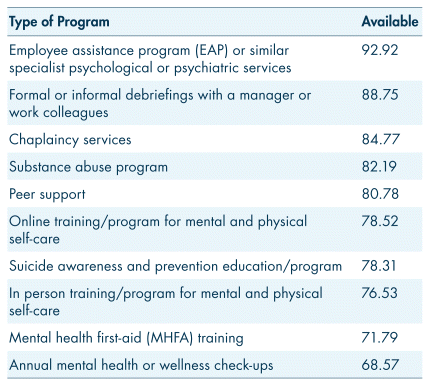
It should be noted that 1.5% of our sample indicated that their agency provided none of the services listed in the survey. About half of the sample (47.72%), indicated that their agency provided all 10 of the services listed (Figure 3).
|
| ||
|
FIGURE 3 Number of services available – percentage of respondents who indicated availability of services (agency-provided) | ||
Collecting information about access to services involved asking officers about access not only to agency-provided services but also to external services. External services include services such as doctors, psychologists, and telephone counseling. Of the 2,678 officers who responded to questions about both agency-provided and external services, 10.87% of officers did not access any services. It may have been that they did not have any agency-provided services available to them, or that despite having services available (whether agency-provided or external), they did not access a service. Examining only those officers who did have services available to them (agency-provided or external) revealed that 9.9% of the sample did not access a service despite having the provision to do so.
Examining agency-provided services only (Figure 4), of those officers who had access to at least one agency-provided service, almost one half of officers accessed one to three services. Despite the almost universal availability of EAP services to officers, when examining engagement with this service, just over one-third of officers who had this service available to them engaged with it (Table IV). The most popular service was online training and programs for mental and physical self-care. This was followed by suicide awareness and prevention education/programs and peer support.
|
| ||
|
FIGURE 4 Available and accessed services (agency-provided) – percentage of respondents who accessed services | ||
TABLE IV Accessed services – agency-provided
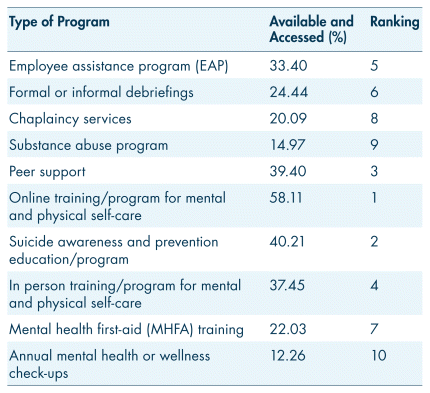
Just under 70% of respondents accesses some form of external services (Figure 5). The most accessed type of service was General Practitioners. This was followed by accessing internet resources for general wellness information and engaging with services provided by psychologists or psychiatrists (Table V).
|
| ||
|
FIGURE 5 Accessed services (external) – number of services accessed | ||
TABLE V Accessed services – external services
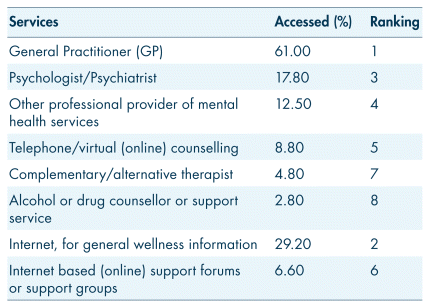
The following two tables provide information about the perceived effectiveness of agency-provided and external services according to officers who have engaged with the service. Table VI indicates that the most effective agency-provided service is peer support, followed by chaplaincy services and EAPs. The most effective external service rated by those officers who had engaged with the service was other professional providers of mental health services, followed by psychologists and psychiatrists and general practitioners. The least effective external services were internet resources, either information around general wellness or internet support forums or support groups (Table VII). Across both agency-provided and external services, the type of services that received the highest effectiveness ratings (the top three rated as most effective) were all external services. This was then followed by the top three agency-provided services of peer support, chaplaincy services, and EAPs.
TABLE VI Effectiveness ratings of services (agency-provided)
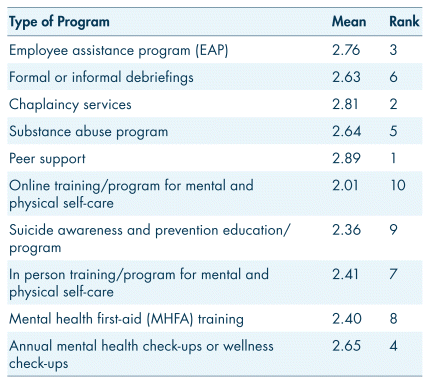
TABLE VII Effectiveness ratings of external services
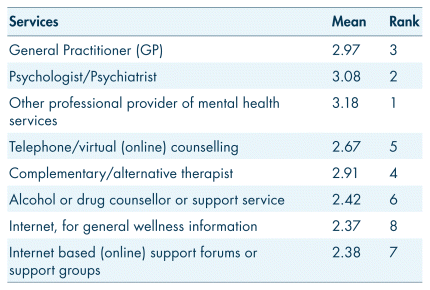
Demographic analysis revealed some interesting differences based on gender. For the top-rated agency-provided services, female officers (M=3.18; SD=1.43) rated peer support significantly more effective compared with their male colleagues (M=2.82; SD=1.14), F(1,519)=7.74, p<.01. Similarly, for the top-rated external services, female officers rated psychologists and psychiatrists (F(1,467)=7.42, p<.01; M=3.39; SD=1.21) and other professional providers of mental health services (F(1,328)=5.91, p<.05; M=3.48; SD=1.16), as being more effective than did male officers (M=3.00; SD=1.23 and M=3.10; SD=1.19, respectively).
The current research provides some insight into the potential impact of service availability and use of services on psychological distress. While the conclusions that can be drawn are far from conclusive or definitive, they do provide some guidance. It is encouraging that across both agency-provided and external services, around 93% of officers who were experiencing some type of psychological distress and who had access to services did use at least one service.
Of those officers who had a service available to them, around 80% of officers experiencing some level of psychological distress accessed at least one agency-provided service. Significant differences were found in the psychological distress being reported by officers as a function of whether or not they had agency-provided services available to them, F(3,2674)=16.17, p<.001. Those officers in agencies with 7 or more services available (M=1.94; SD=0.68) were significantly less likely to report psychological distress than officers in agencies that had no services available to them (M=2.26; SD=0.72); 1 to 3 services (M=2.17; SD=0.75); and 4 to 6 services (M=2.15; SD=0.73) (Figure 6).
.|
| ||||||||||||||||||||
FIGURE 6 Reported psychological distress by number of available services (agency-provided) Examining the proportion of officers who are accessing services as a function of their current level of psychological distress (Figure 7), around 80% of officers who report experiencing mild, moderate, or severe distress are accessing a service when it is available to them. A significant percentage of officers who report being well (76.5%) are also accessing services. Officers experiencing mild, moderate, or severe distress are for the most part accessing one to three services (Figure 8).
External ServicesSimilar to the proportion of officers who report experiencing some level of psychological distress and accessing agency-provided services, almost 80% of officers experiencing some level of psychological distress accessed at least one external service. Also similar to the data reported in reference to agency-provided services, officers who are experiencing mild, moderate, or severe distress are generally accessing one to three external services (Figure 9).
Help-Seeking StigmaAn important aspect of understanding the use and effectiveness of mental health and well-being services in police populations is the stigma associated with help-seeking. In terms of demographics, significant differences were found on mental health stigma as a function of years of service F(4,3068)=4.166, p<.01. Those with fewer than 5 years of service (M=1.89; SD=1.07) compared with those with 5 to 10 years of service (M=2.24; SD=1.74); 11 to 15 years of service (M=2.14; SD=1.16); and 21 and more years of service (M=2.13; SD=1.11) had lower perceptions of mental health stigma (Figure 10). No significant differences were found on mental health stigma by gender or agency size. | ||||||||||||||||||||
|
| ||
|
FIGURE 10 Perception of stigma associated with help-seeking according to years of service | ||
We also considered the potential impact of the availability of services on help-seeking. Significant differences were found on perceptions of help-seeking stigma according to the number of services available in agencies, F(3,2673)=39.90, p<.001. Officers in agencies with seven or more services available (M=1.99; SD=1.05) were significantly less likely to hold perceptions of help-seeking stigma compared with officers in agencies that had one to three services (M=2.58; SD=1.24) and four to six services (M=2.52; SD=1.27) (Figure 11).
|
| ||
|
FIGURE 11 Stigma associated with help-seeking by services available (agency-provided) | ||
The study further revealed significant differences on help-seeking stigma according to whether officers had or had not accessed a service provided by the agency, F(1,2635) = 8.79, p<.01. Officers who had accessed at least one service (M=2.09; SD=1.10) had lower perceptions of help-seeking stigma than those in agencies where a service was available but who did not access it (M=2.25; SD=1.22) (Figure 12).
|
| ||
|
FIGURE 12 Stigma associated with help-seeking by services available and accessed (agency-provided) | ||
We were interested in the potential barriers that help-seeking stigma might pose to those officers who are most in need of services—those experiencing some level of psychological distress. Significant differences were found on perceptions of mental health help-seeking stigma between officers experiencing different levels of psychological distress, F(3,2672)=55.00, p<.001. Compared with officers who were well (M=1.91; SD=1.02), perceptions of mental health stigma were significantly higher for those who were experiencing mild (M=2.23; SD=1.12), moderate (M=2.40; SD=1.22), and severe (M=2.70; SD=1.27) psychological distress. Significant differences were likewise found between those experiencing mild and moderate psychological distress and those experiencing severe psychological distress (Figure 13).
|
| ||
|
FIGURE 13 Stigma associated with help-seeking according to level of psychological distress | ||
The overarching aim of the current study was to provide a national snapshot of availability, access, and perceived effectiveness of wellness services. We have provided insights into whether wellness services are equally available across police agencies and the numbers of police officers who have access to services. Availability is important, but this research also focused on understanding what services officers choose to access. Our research examined what officers perceive to be most effective and how service availability and use is linked to help-seeking stigma and the overall rates of psychological distress in the police population.
The research confirms that developing wellness services must remain an urgent priority for police agencies, as we found that almost one-quarter of officers who responded to the survey were experiencing concerning levels of psychological distress, regardless of the size of the agency in which they worked. Further, elevated rates of psychological distress are present across the span of policing careers. The study highlighted the need to focus increased attention on female officers given their rates of psychological distress. However, what was encouraging was that when female police did access wellness services (particularly, peer support and mental health professionals), they were more likely than their male colleagues to find them effective. The challenge will be to ensure that female officers, who might be most in need of support, have access to services and actively engage with them.
It was likewise encouraging that a very large percentage of officers in this sample indicated that they had accessed a wellness service, whether agency-provided, external, or a combination of both. When considering officers who were most in need of wellness services, those experiencing some level of psychological distress, over 90% of officers accessed at least one agency-provided or external service. For those officers in agencies where services were available, compared with agencies where there were no services, overall rates of psychological distress were lower. Whether agency-provided or external, officers experiencing psychological distress were accessing between one and three services. It should be acknowledged that recent research undertaken by Taylor et al. (2022) using agency level analysis found that 62% of U.S. agencies did not offer wellness services. The findings of both the current research and Taylor et al. (2022) point to the importance of understanding availability at the agency level. In addition, the present research highlights the importance of the proportion of officers in the law enforcement population who have services available to them.
The current research indicates that it is important for police agencies to offer a range of wellness services. Coupled with the findings provided above, we found that greater numbers of services offered by agencies was associated with lower overall reported rates of psychological distress. This points to the critical importance of agency-provided services alongside external services. It is important for police officers to be able to not only choose from a suite of options, but to also simultaneously engage with multiple channels of support. Our findings reveal that agencies have potentially begun to better promote the availability of services, addressing earlier research which found that officers often were unaware of where to access help (Karaffa & Tochkov, 2013). We also found preliminary evidence that greater availability of services may be beneficial in reducing help-seeking stigma.
Echoing previous conclusions, we found that EAP services and peer support are common types of wellness programs provided by agencies. Aligned with formal peer support programs, formal and informal debriefings with managers and colleagues and chaplaincy services were widely available. Peer support, EAP, and chaplaincy services were also among the most effective wellness services, as identified by officers who had accessed them. From this, it appears that agencies are on the right track in the types of programs they are offering; however, the issue of which services officers are accessing needs to be addressed. There is congruency between the availability, access, and effectiveness of peer support, but despite EAP and chaplaincy services being available and rated as effective, officers seem less likely to access these services. It may be that some EAP services are being provided by external providers who are not culturally competent with law enforcement. An often cited criticism of EAP services is that support is being provided by those who have no understanding of police work, yet it is important that police feel comfortable with the service and perceive that it is effective (Newell et al., 2022). Barriers to engagement with services that have been found to be effective, at least in the eyes of officers themselves, need to be further explored.
It should be noted that agency size did have some impact on the availability of services, particularly peer support. These differences are consistent with the findings of previous research (Taylor et al., 2022). It seems that in most agencies, regardless of size, EAP is provided. However, smaller agencies may be more reliant on formal and informal debriefings with managers and colleagues, rather than having access to a formal peer support program. Given the perceived effectiveness of peer support, further research is needed in smaller agencies to determine whether formal and informal debriefings with managers and colleagues are an adequate substitute for formal peer support programs or whether more investment is needed to ensure that all officers, regardless of agency size, have access to this service.
Our research found that, regardless of agency size or officer gender, help-seeking stigma is persistent across most of an officer’s career. Those who are the most in need of wellness services had greater perceptions of stigma than those who were well. Further, those in severe distress had significantly greater perceptions of stigma than those whose levels of distress were lower. Help-seeking stigma is clearly something that still needs to be tackled within police populations. However, this research, in contrast to the findings of Drew and Martin (2021), indicates that encouraging access to services may have a positive impact on help-seeking stigma. Drew and Martin’s (2021) research found that stigma perceptions continued to persist even when officers accessed services and found them helpful. Given these contradictory findings, more research is needed to explore how and why access to services might affect help-seeking stigma and how to increase the willingness of police to seek support.
The current study has provided an important contribution to the literature; however, the research has some limitations. Despite the study including police from across the United States to provide a national overview, the officers involved in the survey were recruited from the FOP membership. Future research should seek to diversify the sample population and include officers outside of the FOP. The current study did rely on officer perceptions. This is potentially advantageous in terms of understanding wellness service effectiveness as it provides a view through the eyes of police themselves; however, future research should be triangulated with more objective effectiveness measures. We have provided an important contribution to better understanding the effectiveness of wellness services and programs for police (Stelnicki et al., 2021), but research on this issue should continue.
The current research has provided a national snapshot of availability, access, perceived effectiveness of wellness services, and help-seeking stigma. We found encouraging results in terms of current availability and access of services by police officers across the country. However, our research highlighted the need to further explore how gender, years of service, and agency size must be considered if we are to gain a more nuanced view of psychological distress, support, and help-seeking stigma.
The authors would like to acknowledge the support of the National Fraternal Order of Police in distributing the survey to its members.
The authors have no conflicts of interest to declare.
*Griffith Criminology Institute, Griffith University, Australia,
†National Fraternal Order of Police, United States.
Asen, J., Colon, I. (1995). Acceptance and use of police department employee assistance programs. Employee Assistance Quarterly, 11(1), 45–54.
Crossref
Berg, A., Hem, E., Lau, B., Ekeberg, O. (2006). Help-seeking in the Norwegian police service. Journal of Occupational Health, 48(3), 145–153.
Crossref PubMed
Bureau of Justice Assistance. (2022). Mental health training: Strategies for small and rural law enforcement agencies. Retrieved from: https://bja.ojp.gov/doc/mental-health-training-strategies.pdf
Carleton, R. N., Afifi, T. O., Taillieu, T., Turner, S., Krakauer, R., Anderson, G. S., McCreary, D., Ricciardelli, R., Cramm, H. A., Groll, D., McCreary, D. R. (2019). Exposures to potentially traumatic events among public safety personnel in Canada. Canadian Journal of Behavioural Science, 51(1), 37–52.
Crossref
Carleton, R. N., Afifi, T. O., Turner, S., Taillieu, T., Vaughan, A. D., Anderson, G. S., Ricciardelli, R., MacPhee, R. S., Cramm, H. A., Czarnuch, S., Hozempa, K., Camp, R. D. (2020). Mental health training, attitudes toward support, and screening positive for mental disorders. Cognitive Behaviour Therapy, 49(1), 55–73. https://doi.org/10.1080/16506073.2019.1575900
Crossref
Corrigan, P. W. (2004) How stigma interferes with mental health care. American Psychology 59, 614–625.
Crossref
Department of Human Services. (2001). Victorian Population Health Survey. Department of Human Services. Melbourne, Victoria.
Drew, J. M., Martin, S. (2021). A national study of police mental health in the United States: Stigma, mental health and help-seeking behaviors. Journal of Police and Criminal Psychology, 36, 295–306.
Crossref
Fraternal Order of Police (FOP). (2023). National Fraternal Order of Police: About us. Retrieved from: https://fop.net/about-the-fop/
Fraternal Order of Police (FOP). (n.d.). Report on FOP/NBC survey of police officer mental and behavioral health. Retrieved from: https://files.fop.net/wp-content/uploads/2021/03/OfficerWellnessSurvey.pdf
Haugen, P. T., McCrillis, A. M., Smid, G. E. Nijdam, M. J. (2017). Mental health stigma and barriers to mental health care for first responders: A systematic review and meta-analysis. Journal of Psychiatric Research, 94, 218–229.
Crossref PubMed
Horan, K. A., Marks, M., Ruiz, J., Bowers, C., Cunningham, A. (2021). Here for my peer: The future of first responder mental health. International Journal of Environmental Research and Public Health, 18, 11097. https://doi.org/10.3390/ijerph182111097
Crossref PubMed
Jeannette, J., Scoboria, A. (2008). Firefighter preferences regarding post-incident intervention. Work Stress, 22, 314–326. https://doi.org/10.1080/02678370802564231
Crossref
Jones, S., Agud, K., McSweeney, J. (2020). Barriers and facilitators to seeking mental health care among first responders: “removing the darkness.” Journal of the American Psychiatric Nurses’ Association, 26(1), 43–54.
Crossref
Karaffa, K. M., Tochkov, K. (2013). Attitudes toward seeking mental health treatment among law enforcement officers. Applied Psychology in Criminal Justice 9(2), 75–99.
Kessler, R. C., Barker, P. R., Colpe, L. J., Epstein, J. F., Gfroerer, J. C., Hiripi, E., Howes, M. J., Normand, S. L., Manderscheid, R. W., Walters, E. E., Zaslavsky A. M. (2003). Screening for serious mental illness in the general population. Archives of General Psychiatry, 60(2), 184–189.
Crossref PubMed
Law Enforcement and Mental Health and Wellness Act. (2017). United States.
Newell, C. J., Ricciardelli, R., Czarnuch, S. M., Martin, K. (2022) Police staff and mental health: Barriers and recommendations for improving help-seeking. Police Practice and Research, 23(1), 111–124. https://doi.org/10.1080/15614263.2021.1979398
Crossref
Regehr, C., Carey, M. G., Wagner, S., Alden, L. E., Buys, N., Corneil, W., Fyfe, T., Matthews, L., Randall, C., White, C., Fraess-Phillips, A., Krutop, E., White, N., Fleischmann, M. (2019). A systematic review of mental health symptoms in police officers following extreme traumatic exposures. Police Practice and Research, 22(1), 225–239.
Crossref
Ruderman Family Foundation. (2018). Ruderman white paper on mental health and suicide of first responders. Retrieved from: https://rudermanfoundation.org/white_papers/police-officers-and-firefighters-aremore-likely-to-die-by-suicide-than-in-line-of-duty/
Stelnicki, A. M., Jamshidi, L., Fletcher, A. J., Carleton, R. N. (2021). Evaluation of before operational stress: A program to support mental health and proactive psychological protection in public safety personnel. Frontiers in Psychology, 12, 511755.
Crossref PubMed
Taylor, B. G., Liu, W., Mumford, E. A. (2022). A national study of the availability of law enforcement agency wellness programming for officers: A latent class analysis. International Journal of Police Science and Management, 24(2), 175–189.
Vogel, D. L., Wade, N. G., Ascheman, P. L. (2009). Measuring perceptions of stigmatization by others for seeking psychological help: Reliability and validity of a new stigma scale with college students. Journal of Counseling Psychology, 56, 301–308.
Crossref
Weir, B., Cunningham, M., Abraham, L., Allanson-Oddy, C. (2017). Military veteran engagement with mental health and well-being services: A qualitative study of the role of the peer support worker. Journal of Mental Health, 30, 1–7. https://doi.org/10.1080/09638237.2017.1370640
Wheeler, C., Fisher, A., Jamiel, A., Lynn, T. J., Hill, W. T. (2021). Stigmatizing attitudes toward police officers seeking psychological services. Journal of Police and Criminal Psychology, 36, 1–7.
Crossref
White, A. K., Shrader, G., Chamberlain, J. (2016). Perceptions of law enforcement officers in seeking mental health treatment in a right-to-work state. Journal of Police and Criminal Psychology, 31, 141–154.
Crossref
This work is licensed under the Creative Commons Attribution-NonCommercial-NoDerivatives 4.0 International License. To view a copy of this license, visit http://creativecommons.org/licenses/by-nc-nd/4.0/. For commercial re-use, please contact sales@sgpublishing.ca.
Journal of CSWB, VOLUME 8, NUMBER Suppl 1, February 2023